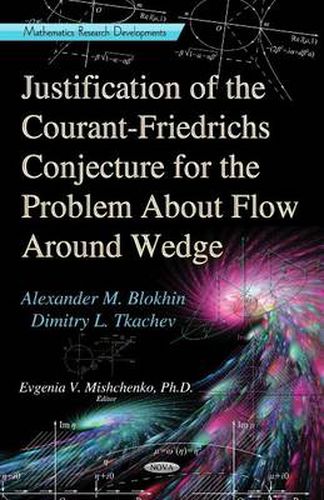Readings Newsletter
Become a Readings Member to make your shopping experience even easier.
Sign in or sign up for free!
You’re not far away from qualifying for FREE standard shipping within Australia
You’ve qualified for FREE standard shipping within Australia
The cart is loading…






The classical problem about a steady-state supersonic flow of an inviscid non-heat-conductive gas around an infinite plane wedge under the assumption that the angle at the vertex of the wedge is less than some limit value is considered. The gas is supposed to be in the state of thermodynamical equilibrium and admits the existence of a state equation. As is well-known, the problem has two discontinuous solutions, one of which is associated with a strong shock wave (the gas velocity behind the shock wave is less than the sound speed) and the second one corresponds to the weak shock wave (the gas velocity behind the shock wave is, in general, larger than the sound speed) (Courant R, Friedrichs K.O. Supersonic flow and shock waves. N. Y.: Interscience Publ. Inc., 1948). One of the possible explanations of this phenomenon was given by Courant and Friedrichs. They conjectured that the solution corresponding to the strong shock wave is instable in the sense of Lyapunov, whereas the solution corresponding to the weak shock wave is stable. This conjecture has been confirmed in a number of studies in which either particular cases were considered or the proposed argumentation was given at the qualitative (mostly, physical) level of rigor. In this monograph, the Courant-Friedrichs conjecture is strictly mathematically justified at the linear level. The mechanism of generating the instability for the case of a strong shock is explained. The smoothness of the solution essentially depends on the peculiarity of the boundary at the vertex of the wedge. The situation with a weak shock drastically differs from the previous one. It is amazing but for the compactly supported initial data the solution to the linear problem reaches the steady state regime infinite time.
$9.00 standard shipping within Australia
FREE standard shipping within Australia for orders over $100.00
Express & International shipping calculated at checkout
The classical problem about a steady-state supersonic flow of an inviscid non-heat-conductive gas around an infinite plane wedge under the assumption that the angle at the vertex of the wedge is less than some limit value is considered. The gas is supposed to be in the state of thermodynamical equilibrium and admits the existence of a state equation. As is well-known, the problem has two discontinuous solutions, one of which is associated with a strong shock wave (the gas velocity behind the shock wave is less than the sound speed) and the second one corresponds to the weak shock wave (the gas velocity behind the shock wave is, in general, larger than the sound speed) (Courant R, Friedrichs K.O. Supersonic flow and shock waves. N. Y.: Interscience Publ. Inc., 1948). One of the possible explanations of this phenomenon was given by Courant and Friedrichs. They conjectured that the solution corresponding to the strong shock wave is instable in the sense of Lyapunov, whereas the solution corresponding to the weak shock wave is stable. This conjecture has been confirmed in a number of studies in which either particular cases were considered or the proposed argumentation was given at the qualitative (mostly, physical) level of rigor. In this monograph, the Courant-Friedrichs conjecture is strictly mathematically justified at the linear level. The mechanism of generating the instability for the case of a strong shock is explained. The smoothness of the solution essentially depends on the peculiarity of the boundary at the vertex of the wedge. The situation with a weak shock drastically differs from the previous one. It is amazing but for the compactly supported initial data the solution to the linear problem reaches the steady state regime infinite time.